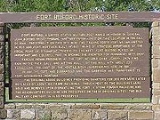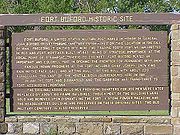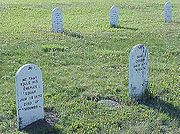
Fort Buford
Encyclopedia
Fort Buford was a United States Army base at the confluence of the Missouri
and Yellowstone River
s in North Dakota
, and the site of Sitting Bull
's surrender in 1881.
Company C, 2nd Battalion, 13th Infantry
, 70 enlisted men commanded by Capt. (Brevet Lt. Col.) William G. Rankin, first established a camp on the site on June 15, 1866, with orders to build a post; the only tools they had to do it with were the company axes. The fort was named after John Buford
, a Union Army
cavalry general during the American Civil War
. On July 28, Fort Buford's garrison was redesignated as Company C, 22nd Infantry.
The second night after arrival the camp was attacked by Indians, who were driven off with one soldier wounded. The next day the Indians attacked and attempted to drive off the company's herd of beef cattle, but were repulsed and two Indians killed. Indian attacks upon the camp were of almost daily occurrence during the summer and fall. Parties of men cutting and rafting logs from the mouth of the Yellowstone were often attacked and driven to camp, where the fighting often lasted from two to six hours with losses on both sides.
Three civilian wood cutters were killed at the mouth of the Yellowstone in December. Lieut. Hiram H. Ketchum with sixty men reacted, drove off the Indians and recovered the bodies with slight loss to his detachment. According to the regimental history, the Indians boasted that they intended to annihilate the soldiers and during the winter besieged the post; the troops were virtually cut off from water (the Missouri River) and had to sink wells near the quarters. Captain Rankin's wife spent the winter in camp, enduring the hardships and dangers with the troops.
The harassing raids led to the perpetration of a hoax, the "Fort Buford Massacre", purporting that the fort had been wiped out, Capt. Rankin captured and tortured to death, and Rankin's wife captured and abused. The hoax was eventually exposed by Rankin himself. The episode began when the Philadelphia Inquirer ran a story April 1, 1867, based on a letter allegedly written from the fort, which was then picked up and run the next day nationwide. It was given "legs" by a letter published April 6 in the Army and Navy Journal, attributed to the wife of a prominent Army officer, confirming the massacre. Although by April 4 many newspapers had begun to question the validity of the report, The Chicago Daily Times
, Detroit Free Press
, New York Daily Tribune, New York Times, and Boston Herald
, among others, continued to feed the rumors with further stories for another month, many of them accusing the Army and the Johnson Administration
of covering up the massacre.
Fort Buford was expanded in 1867 and again in 1871–1872 from a one-company 360-foot square frontier stockade to a six-company infantry post, and became a key element in the supply route for the military campaigns of 1876–1877 in Montana
. The end of the Indian wars and the remoteness of the post resulted in its deterioration, and it was abandoned by the Army on October 1, 1895.
Today the North Dakota State Historical Society runs Fort Buford as Fort Buford State Historic Site.


Missouri River
The Missouri River flows through the central United States, and is a tributary of the Mississippi River. It is the longest river in North America and drains the third largest area, though only the thirteenth largest by discharge. The Missouri's watershed encompasses most of the American Great...
and Yellowstone River
Yellowstone River
The Yellowstone River is a tributary of the Missouri River, approximately long, in the western United States. Considered the principal tributary of the upper Missouri, the river and its tributaries drain a wide area stretching from the Rocky Mountains in the vicinity of the Yellowstone National...
s in North Dakota
North Dakota
North Dakota is a state located in the Midwestern region of the United States of America, along the Canadian border. The state is bordered by Canada to the north, Minnesota to the east, South Dakota to the south and Montana to the west. North Dakota is the 19th-largest state by area in the U.S....
, and the site of Sitting Bull
Sitting Bull
Sitting Bull Sitting Bull Sitting Bull (Lakota: Tȟatȟáŋka Íyotake (in Standard Lakota Orthography), also nicknamed Slon-he or "Slow"; (c. 1831 – December 15, 1890) was a Hunkpapa Lakota Sioux holy man who led his people as a tribal chief during years of resistance to United States government policies...
's surrender in 1881.
Company C, 2nd Battalion, 13th Infantry
13th Infantry Regiment (United States)
The 13th Infantry Regiment is a United States Army infantry regiment whose battalions are currently tasked as basic training battalions.- History :...
, 70 enlisted men commanded by Capt. (Brevet Lt. Col.) William G. Rankin, first established a camp on the site on June 15, 1866, with orders to build a post; the only tools they had to do it with were the company axes. The fort was named after John Buford
John Buford
John Buford, Jr. was a Union cavalry officer during the American Civil War, with a prominent role at the start of the Battle of Gettysburg.-Early years:...
, a Union Army
Union Army
The Union Army was the land force that fought for the Union during the American Civil War. It was also known as the Federal Army, the U.S. Army, the Northern Army and the National Army...
cavalry general during the American Civil War
American Civil War
The American Civil War was a civil war fought in the United States of America. In response to the election of Abraham Lincoln as President of the United States, 11 southern slave states declared their secession from the United States and formed the Confederate States of America ; the other 25...
. On July 28, Fort Buford's garrison was redesignated as Company C, 22nd Infantry.
The second night after arrival the camp was attacked by Indians, who were driven off with one soldier wounded. The next day the Indians attacked and attempted to drive off the company's herd of beef cattle, but were repulsed and two Indians killed. Indian attacks upon the camp were of almost daily occurrence during the summer and fall. Parties of men cutting and rafting logs from the mouth of the Yellowstone were often attacked and driven to camp, where the fighting often lasted from two to six hours with losses on both sides.
Three civilian wood cutters were killed at the mouth of the Yellowstone in December. Lieut. Hiram H. Ketchum with sixty men reacted, drove off the Indians and recovered the bodies with slight loss to his detachment. According to the regimental history, the Indians boasted that they intended to annihilate the soldiers and during the winter besieged the post; the troops were virtually cut off from water (the Missouri River) and had to sink wells near the quarters. Captain Rankin's wife spent the winter in camp, enduring the hardships and dangers with the troops.
The harassing raids led to the perpetration of a hoax, the "Fort Buford Massacre", purporting that the fort had been wiped out, Capt. Rankin captured and tortured to death, and Rankin's wife captured and abused. The hoax was eventually exposed by Rankin himself. The episode began when the Philadelphia Inquirer ran a story April 1, 1867, based on a letter allegedly written from the fort, which was then picked up and run the next day nationwide. It was given "legs" by a letter published April 6 in the Army and Navy Journal, attributed to the wife of a prominent Army officer, confirming the massacre. Although by April 4 many newspapers had begun to question the validity of the report, The Chicago Daily Times
Chicago Sun-Times
The Chicago Sun-Times is an American daily newspaper published in Chicago, Illinois. It is the flagship paper of the Sun-Times Media Group.-History:The Chicago Sun-Times is the oldest continuously published daily newspaper in the city...
, Detroit Free Press
Detroit Free Press
The Detroit Free Press is the largest daily newspaper in Detroit, Michigan, USA. The Sunday edition is entitled the Sunday Free Press. It is sometimes informally referred to as the "Freep"...
, New York Daily Tribune, New York Times, and Boston Herald
Boston Herald
The Boston Herald is a daily newspaper that serves Boston, Massachusetts, United States, and its surrounding area. It was started in 1846 and is one of the oldest daily newspapers in the United States...
, among others, continued to feed the rumors with further stories for another month, many of them accusing the Army and the Johnson Administration
Andrew Johnson
Andrew Johnson was the 17th President of the United States . As Vice-President of the United States in 1865, he succeeded Abraham Lincoln following the latter's assassination. Johnson then presided over the initial and contentious Reconstruction era of the United States following the American...
of covering up the massacre.
Fort Buford was expanded in 1867 and again in 1871–1872 from a one-company 360-foot square frontier stockade to a six-company infantry post, and became a key element in the supply route for the military campaigns of 1876–1877 in Montana
Montana
Montana is a state in the Western United States. The western third of Montana contains numerous mountain ranges. Smaller, "island ranges" are found in the central third of the state, for a total of 77 named ranges of the Rocky Mountains. This geographical fact is reflected in the state's name,...
. The end of the Indian wars and the remoteness of the post resulted in its deterioration, and it was abandoned by the Army on October 1, 1895.
Today the North Dakota State Historical Society runs Fort Buford as Fort Buford State Historic Site.


See also
- Fort Union Trading Post National Historic SiteFort Union Trading Post National Historic SiteFort Union Trading Post National Historic Site is the site of a partially reconstructed trading post on the Missouri River and the North Dakota/Montana border twenty-five miles from Williston. It is one of the earliest declared National Historic Landmarks of the United States...
, nearby site - Missouri-Yellowstone Confluence Interpretive CenterMissouri-Yellowstone Confluence Interpretive CenterThe Missouri-Yellowstone Confluence Interpretive Center is a museum near Williston, North Dakota. It is dedicated to telling the story of the confluence of the Yellowstone and the Missouri Rivers in the western section of North Dakota near the Montana border. It features exhibits on the geography,...
Further reading
- Barnes, Jeff. Forts of the Northern Plains: Guide to Historic Military Posts of the Plains Indian Wars. Mechanicsburg, PA: Stackpole Books, 2008.

